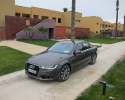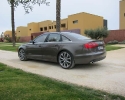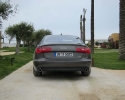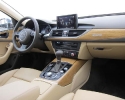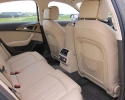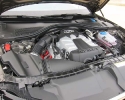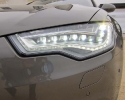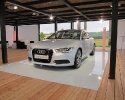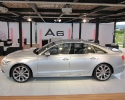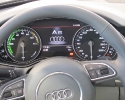2012 Audi A6 first drive
The all-new Audi A6 is a milestone of sorts for the company. The A6 line has been one of the foundations that Audi’s current success is built on. Dating back to 1967 when the first Audi 100 was introduced, the 2012 A6 is the seventh model in the C segment for the Ingolstadt based manufacturer.
It hardly seems possible that the sixth generation A6 has been with us since 2004. Seven years in the life cycle of a car model is equivalent to an eternity. However, the subtle changes to the front and rear clips in 2008, have kept the appearance current and as a result, it still sold well. According to Audi sales figures the model has averaged 1000 units per year in Canada since the second year of availability.
Despite its popularity, a new A6 was needed to challenge and perhaps surpass other manufacturers’ offerings in this category. The new 2012 model has further evolved Audi’s vision of a full sized executive sedan.
The global launch of the vehicle was held on the sun soaked island of Sicily. Once on the ground and after a 90 minute ride to our hotel, I finally got a look at the car up close. At first glance, the new exterior styling was not a revolutionary reworking of the outgoing model. What it did represent was a progression – or evolution – of the C segment sedan. The corporate styling cues from the flagship A8 and A7 sport-back coupe had been added for good measure. The overall shape was familiar, yet more aggressive. The high “Tornado line” from the A7 was integrated in a more subtle fashion arcing back from the front headlight cluster. The lower creased swipe that flows upward from the front wheel-well was more pronounced. These added a sporting flair and bold stance while somehow maintaining the required conservative statement.
From the outside the vehicle is now 80 mm shorter and 91 mm wider. Consider it is now 40 mm lower and it becomes apparent why the A6’s drag coefficient has been lowered to 0.26. Now that it is slipperier than a Porsche 911 in the wind tunnel, you appreciate the more aggressive stance of this newcomer. Designers have also moved the front axle 71 mm closer to the front of the vehicle. This has created a longer wheelbase for a smoother ride, better fore and aft weight balance and visually dramatic shorter wheel overhangs.
After a nights rest we were finally able to get behind the wheel. Inside the cabin Audi designers have once again delivered a bespoke interior that bests most if not all in the premium full-sized sedan class. The dash is reminiscent of the layout found in the A8 or A7. It steps back from the driver and wraps around onto the door panels. This dash sits up higher in the A6 than on the coupe-like A7, for a more conventional sedan feeling.
The addition of 11 exterior and interior colour and material schemes, gives buyers a near endless number of combinations to choose from. One example, the Beaufort Oak veneer, resembles boat decking and like other trims, it not only wraps around the cockpit, but also covers the center console and rear door trim panels. It harkens back to the early days of custom coachwork on premium vehicles.
The weather for our wave of journalists had been remarkably dry given the rain that has plagued the earlier programs. Nestling into the standard leather seats I noticed that the vehicle is equipped with multi-adjustable sports seats not the ‘comfort ‘seats. The ‘comfort’ derives from the optional climate controlled air emanating from the seats or the massaging mechanism installed. Visually the A6 seemed roomier than the previous model and appeared to have more rear seat room than the 5 series or E class.
Sitting up high to my right was an 8-inch lcd panel that has rose out of the dashboard. This proved to be the latest MMI entertainment interface system for the A6. It comes in two versions, this version borrowed from the A8 or a 5-inch fixed LCD display. The MMI system is recognized as one of the most intuitive human/electronic interface systems available, yet it remains as simple to use as ever. Another system brought over from the A8 is an available built in mobile data receiver. The system feeds the GPS system map information with satellite images from Google Earth. Again, the system is widely recognized as the industries finest. The Achilles heel so far has been convincing Canadian wireless providers to step up with the required technology to interact with the vehicle. Of course the fact the on-board system will also transform into a mobile hotspot for up to 8 devices could spell financial ruin should you not have a generous data plan.
Scrolling through the onscreen options, I came across the now standard Audi Drive select menu, to tailor the vehicle’s driving dynamics by adjusting the steering, transmission, throttle or suspension. Another performance feature – included on European vehicles – is the adaptive air suspension system. The suspension reacts and essentially eliminates body roll in corners and will lower the vehicle at speed. Choosing a sport setting in the Drive select system also tightens up the shock response, yielding a firmer ride.
Having done the pre-drive check, it was time to take the A6 for a spin. On the road, the 300 HP 3.0L TFSI super-charged engine was a familiar friend. Our test vehicles were fitted with Euro-spec 7 speed S-Tronic transmission. The Euro models had a ‘crisper’ feel than the 8 speed tiptronic automatic transmissions used in Canada. Overall performance should be relatively similar with a smoother execution. The real surprise was learning that the 3.0L TDI diesel engine has been approved for the Canadian market. This marks the first time Audi will offer a diesel engine in this segment. In real world driving there was little audible distinction between the 3.0L diesel and the 3.0L TFSI V6. The only observed difference was a more linear application of power off the line with the TDI motor. With 245 HP and 369 lb-ft of torque available as early as 1400 RPM the motor is a model of refinement. Both 3.0L engines pack a wallop. Zero to 100 kms/hr in the 3.0TFSI was recorded in 5.5 seconds, while the 3.0TDI yielded a 6.1 second time.
Canadian buyers will be offered an optional measure of fuel economy in the near future when the 2.0L TFSI engine, used in the Q5, is brought into play. Two years forward, the Hybrid version of the A6 should be offered for sale in our market.
Drivers in Sicily are apparently not as hell bent on destruction as in other parts of Italy I’ve been to. However, in reflecting on safety equipment Audi has clearly focused on both passive and active safety systems in the vehicle. In terms of passive systems, engineers managed to improve structural integrity of the crash crumple zones and side impact beams, to limit incursion in the event of a collision.
Audi has loaded up this vehicle with active safety systems. Aside from a raft of airbags, antilock brakes and Electronic stability control, buyers can now rely on items like a lane departure warning system that not only warns you, but will actually steer the vehicle back into the lane you are attempting to leave. The Audi Pre-sense system uses front and rear facing radar systems to monitor whether your vehicle can stop safely in traffic. If the system senses a collision with either a vehicle ahead or from behind, it automatically closes all windows (including the sunroof), tightens and locks the seat belts, throws on the hazard lights and begins emergency braking.
An optional colour coded “heads up” information system projects the vehicles speed on the inside of the windshield and also advises you of speed limit information gathered by camera systems scanning the side of the road. In keeping with the enhanced pedestrian safety regulation around the Globe, radar and ultrasonic sensors mounted fore and aft have been programmed to identify human pedestrian profiles. When recognized, the driver is notified through the heads up display or on the TFT portion of the dashboard. On this trip the most useful feature so far has been the speed limit indicator which somehow manages to register speed changes I am clearly too involved to notice.
Another feature that should be available in Canada is an adaptive cruise control system. Again using the sensors mounted on-board, the system can be programmed to maintain a minimum distance from the vehicle ahead should traffic slow. Taking the concept a step further, engineers have now built in a facility to have the system stay engaged for shorts amount of time in stop and go traffic. Couple this capability with the available self-parking system and a nefarious plan to make drivers redundant seems plausible.
At every turn buyers will have the opportunity to customize their A6. Even with headlight systems, buyers will have the choice between traditional halogen, upscale Xenon or state of the art, LED lighting. One feature offered in Europe with the top of the line LED lighting, is an adaptive headlight system. The on-board GPS system with Google maps integration, communicates with the vehicle to tailor the headlight system for the road driven on. The system will switch between hi and low beams automatically. Shockingly, the lights also split to hi-beam on the right and low on the left for oncoming traffic as it rolls down a country road. Approaching an intersection will activate cornering lights on the side.
Efficiency has become the focus of many European brands in the face of fuel taxes and Carbon emission awareness in their home markets. Audi has taken a leadership role in this research and its implementation. The use of lightweight materials has been at the core of Audi’s most recent development. The inner and outer door skins, hood and trunk panels, as well as the inner strut towers are made of aluminum. Aluminum gives the new model a 20% weight advantage over the same vehicle made from steel. Coupled with other efficiencies such as; a redesigned air-conditioning systems, lighter fuel and exhaust systems the new A6 weighs 80kgs less than the model it replaces. Amongst its competitors the A6 sits in the middle of the pack in terms of weight, however nearly all those vehicles lack the all wheel drive running gear of the Quattro equipped A6. With the addition of the engine automatic stop/start system in Europe to cut down on engine idling, Audi claims that the redesigned A6 is 14% more fuel efficient than the previous version. In real terms, a Euro-spec A6 with the 3.0L TFSI gasoline engine is rated at 8.2L/100 kms of driving. The 3.0L TDI diesel engine returns an even more spectacular 6.0L/100 kms on a combined circuit.
All these facts and figures can be somewhat daunting but from the drivers’ seat, I was actually surprised how little attention this vehicle required. I have to admit being distracted by the endless citrus orchards and vineyards that lined the roads around Sicily. As we left the main roads – in search of the best olive oil money could buy – it became clear the choice of location was intentional. What better place to demonstrate the capabilities of the new A6? Shedding unnecessary weight from the A6 transformed the driving dynamics of the new model. The entire chassis is more agile than any of the earlier A6 models. The vehicle managed to tame the mountain roads and tight village tracks we navigated. On one occasion entering a walled town at the top of a mountain, the wide-bodied A6 could go no further. Apparently the A6 was wider than the hand-carts pushed by the soldiers that once traversed these roads centuries earlier. Backing down the hill with the help of the rear-mounted camera – and excellent outward visibility – neither I, nor the passenger, broke a sweat.
On the open road the A6 reflected equal parts autobahn bullet and all-wheel-drive slot car. Much of the improved cornering prowess can be attributed to either the adaptive air suspension or optional Sport Differential installed on the vehicles. The system over-speeds the outside rear wheel while cornering, helping to power the vehicle through corners. The new A6 should now be considered a bona-fide contender in any handling comparison amongst its European counterparts,
Audi plans to sell 1000 units a year in Canada, which is roughly the same number of A6’s sold over the past few years. One would expect this technological assault on other manufacturers’ sedans to yield higher sales figures. The truth is, with the addition of the A7 Sport-back, Audi now has 2 vehicles wooing buyers in relatively similar segments. The strategy has been to expand its market share with conquest sales from rival manufacturers.
The 2012 A6 is slated to list in the same ballpark as the previous model. All that extra equipment, ability, and safety features, makes the new A6 an incredible value added proposition. I can’t wait to experience the S6 version of this barnstormer.
The new A6 is now on sale in Canada, starting at $58,800.
Copyright © Auto Reviews Online 2016 | Privacy & Terms of Use | info@autoreviewsonline.com | Website by Brolly Media



